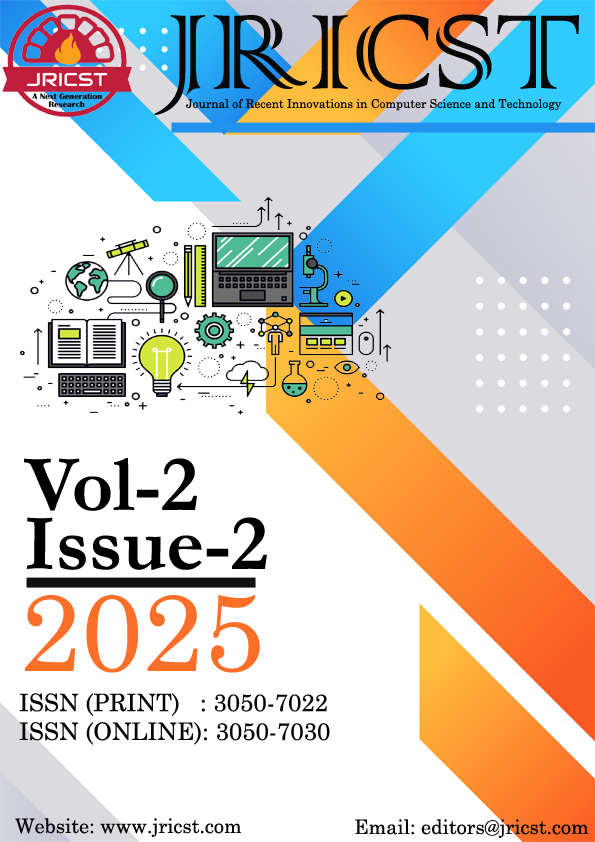Human Skin Disease Detection and Classification Using Ensemble Learning
DOI:
https://doi.org/10.70454/JRICST.2025.20212Keywords:
Skin Disease Classification, Ensemble Learning, Deep Learning, Convolutional Neural Networks (CNNs), Medical Image AnalysisAbstract
Skin disorders are thought to be common in humans and carry several invisible risks, including the potential to cause psychological sadness, lower self-esteem, and, in more serious cases, skin cancer. Medical professionals must diagnose these skin conditions, but doing so requires highly sophisticated diagnostic tools because they have trouble seeing clearly while examining images of the conditions. This paper focuses on skin disease detection and classification using ensemble learning. This is done using Multiple Skin Disease Detection and Classification data sets from the ISIC Archive through employing the bagging, boosting, and stacking methodologies for better diagnosis. To compare the proposed ensemble of CNN models and individual CNN models, the observations were made. This strategy is useful for dermatologists to identify skin diseases at an early stage or at the first instance to prevent further deterioration of the skin health of their patients.
Downloads
References
[1] Ganaie, M.A., Hu, M., Malik, A.K., Tanveer, M. and Suganthan, P.N. (2021) 'Ensemble deep learning: A review', arXiv preprint arXiv:2104.02395.
[2] Goyal, M., Oakley, A., Bansal, P. and Dancey, D. (2025) 'Next-generation approach to skin disorder prediction employing hybrid deep transfer learning models', Frontiers in Big Data, 8, p.1503883.
[3] Khan, A., Rauf, Z., Sohail, A., Khan, A.R., Asif, H., Asif, A. and Farooq, U. (2023). A survey of the vision transformers and their CNN-transformer based variants. Artificial Intelligence Review, 56(Suppl 3), pp.2917-2970.
[4] Khan, M.A., Javed, K., Sharif, M., Saba, T., Rehman, A. and Uddin, M. (2023) 'A deep-ensemble-learning-based approach for skin cancer classification', Electronics, 12(6), p.1342.
[5] Kumar, R., Srivastava, R. and Srivastava, S. (2023) 'Ensemble learning for disease prediction: a review', Journal of Biomedical Informatics, 135, p.104215.
[6] Li, X., Shen, L., Gao, F., Zhang, Y. and Liu, Y. (2023) 'A skin disease classification model based on multi-scale combined convolutional neural networks', Frontiers in Medicine, 10, 11840012.
[7] Mohan, J., Sivasubramanian, A., Sowmya, V. and Vinayakumar, R. (2024) 'Enhancing skin disease classification leveraging transformer-based deep learning architectures and explainable AI', arXiv preprint arXiv:2407.14757.
[8] Schmidt, A. (2020). ‘Regulatory challenges in healthcare IT: Ensuring compliance with HIPAA and GDPR.’ Academic Journal of Science and Technology, 3(1), pp.1-7.
[9] Singh, P. (2023). Multiple Skin Disease Detection and Classification. [online] Kaggle.com. Available at: https://www.kaggle.com/datasets/pritpal2873/multiple-skin-disease-detection-and-classification (Accessed 4 Mar. 2025).
[10] Yang, Y., Lv, H., Chen, Z., Wang, W. and Zhang, J. (2022) 'A novel ensemble learning method for medical image classification', Applied Sciences, 12(5), p.2428.
[11] Xiaoyu He, Yong Wang, Xiaojing Wang, Weihong Huang, Shuang Zhao, Xiang Chen,Simple-Encoded evolving convolutional neural network and its application to skin disease image classification, Swarm and Evolutionary Computation,Volume 67,2021,100955,ISSN 2210- 6502,https://doi.org/10.1016/j.swevo.2021.100955.
[12] SameenaPathan, K. GopalakrishnaPrabhu, P.C. Siddalingaswamy, Techniques and algorithms for computer aided diagnosis of pigmented skin lesions—A review, Biomedical Signal Processing and Control,Volume 39,2018,Pages 237-262,ISSN 1746-8094,https://doi.org/10.1016/j.bspc.2017.07.010.
[13] Mohamed A. Elashiri, Arunachalam Rajesh, Surya Nath Pandey, Surendra Kumar Shukla, ShabanaUrooj, Aime' Lay-Ekuakille,Ensemble of weighted deep concatenated features for the skin disease classification model using modified long short term memory, Biomedical Signal Processing and Control,Volume 76,2022,103729,ISSN 1746-8094,https://doi.org/10.1016/j.bspc.2022.103729.
[14] FoahomGouabou, A.C.; Iguernaissi, R.; Damoiseaux, J.-L.; Moudafi, A.; Merad, D. End-to-End Decoupled Training: A Robust Deep Learning Method for Long-Tailed Classification of Dermoscopic Images for Skin Lesion Classification. Electronics 2022, 11, 3275. https://doi.org/10.3390/electronics11203275
[15] Shetty, B., Fernandes, R., Rodrigues, A.P. et al. Skin lesion classification of dermoscopic images using machine learning and convolutional neural network. Sci Rep 12, 18134 (2022). https://doi.org/10.1038/s41598-022-22644-9
Downloads
Published
Issue
Section
License
Copyright (c) 2025 Vimal Kumar, Jeetu Rani (Author)

This work is licensed under a Creative Commons Attribution 4.0 International License.
This is an Open Access article distributed under the term's of the Creative Common Attribution 4.0 International License permitting all use, distribution, and reproduction in any medium, provided the work is properly cited.






